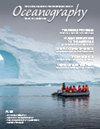在海洋学科的界面:使用自主海底设备研究浅水区以下的生物污染
IF 2.8
4区 地球科学
Q1 OCEANOGRAPHY
引用次数: 3
摘要
研究的目的和范围人类活动向深海地区的扩展导致浅水区(<50米深;Jouffray et al., 2020)。这些结构提供了一种新型的栖息地——在柔软的沉积物底部或上面的硬基质(例如,Degraer等,2020)。与浅水相比,对这些结构上生物污染生物的发育、组成和丰度的研究要少得多(Cowie, 2010)。在50 m深度以下的硬基质上,生物污染过程的时间尺度上只有零星的观测结果(例如,Apolinario和Coutinho, 2009;考伊,2010;Bellou et al., 2012;Degraer et al., 2020)。因此,我们对生物污染时空尺度及其随深度变化的理解是有限的。增加可用于解决污染群落发展的数据量的一种方法是使用不同持续时间的重复收集长期观察数据(例如,Hutchison et al., 2020)。这些耗时费力的研究通常是基于安装在不同深度的专门设计的装置(例如,Railkin, 2004)。在这里,我们提出了一种简单的方法来收集生物污染观测以及主要的水文和地球物理数据。在标准海洋学仪器上增加一小块测试板,可以帮助填补我们对不太为人所知地区生物污染群落发展的理解空白。在这里,我们首先对海洋生物污染的知识现状进行了文献综述,介绍了该领域的术语、概念和知识差距。然后,我们提出了两个案例研究来支持我们提出的收集生物污垢信息的方法,随后确定了进一步的步骤、建议和研究机会,这些建议和研究机会将提高我们对海洋中不断增加的水深的生物污垢的理解。本文章由计算机程序翻译,如有差异,请以英文原文为准。
At the Interface of Marine Disciplines: Use of Autonomous Seafloor Equipment for Studies of Biofouling Below the Shallow-Water Zone
AIMS AND SCOPE OF THE STUDY The expansion of human activities into deep sea areas is leading to an increase in the number of manmade structures on the seafloor below the shallowwater zone (<50 m depth; Jouffray et al., 2020). These structures provide a new type of habitat— hard substrate on or above the soft, sedimented bottom (e.g., Degraer et al., 2020). The development, composition, and abundance of biofouling organisms on these structures are much less studied than those in the shallow waters (Cowie, 2010). Only patchy observations exist on the temporal scale of the biofouling process on hard substrates below 50 m depth (e.g., Apolinario and Coutinho, 2009; Cowie, 2010; Bellou et al., 2012; Degraer et al., 2020). Thus, our understanding of biofouling temporal and spatial scales, and its variation with depth, is limited. One way to increase the amount of data available for addressing the development of fouling communities is collection of long-term observations using replicates of different duration (e.g., Hutchison et al., 2020). These timeand effortconsuming studies are usually based on specially designed installations mounted at different depths (e.g., Railkin, 2004). Here, we propose a simple approach for collecting biofouling observations along with primary hydrological and geophysical data. The small addition of test panels to standard oceanographic instrumentation can help to fill the gaps in our understanding of the development of biofouling communities in lesser-known areas. Here, we first present a literature review of the state of knowledge of marine biofouling to introduce the field’s terms, concepts, and knowledge gaps. We then present two case studies that support our proposed approach to collecting biofouling information, followed by identification of further steps, recommendations, and research opportunities that will improve our understanding of biofouling with increasing water depth in the ocean.
求助全文
通过发布文献求助,成功后即可免费获取论文全文。
去求助
来源期刊

Oceanography
地学-海洋学
CiteScore
6.10
自引率
3.60%
发文量
39
审稿时长
6-12 weeks
期刊介绍:
First published in July 1988, Oceanography is the official magazine of The Oceanography Society. It contains peer-reviewed articles that chronicle all aspects of ocean science and its applications. In addition, Oceanography solicits and publishes news and information, meeting reports, hands-on laboratory exercises, career profiles, book reviews, and shorter, editor-reviewed articles that address public policy and education and how they are affected by science and technology. We encourage submission of short papers to the Breaking Waves section that describe novel approaches to multidisciplinary problems in ocean science.
 求助内容:
求助内容: 应助结果提醒方式:
应助结果提醒方式:


